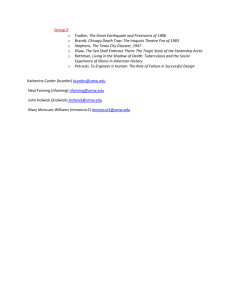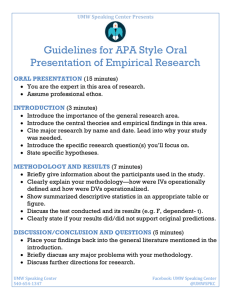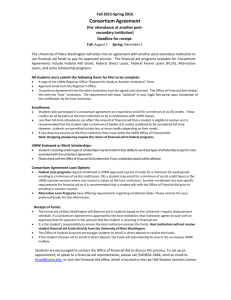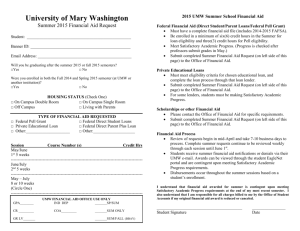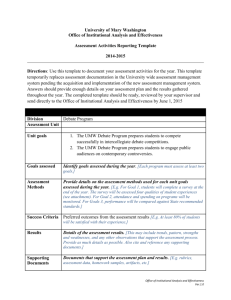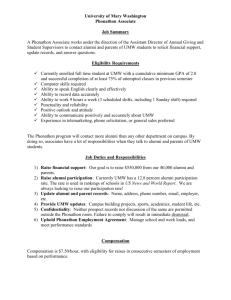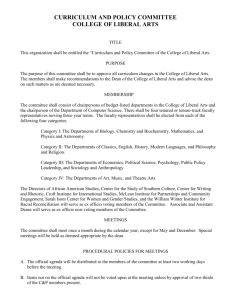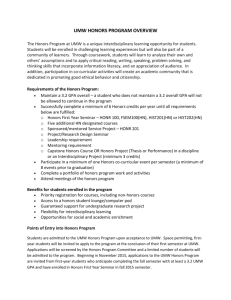Mary Washington 2020 - Office of the Provost
advertisement
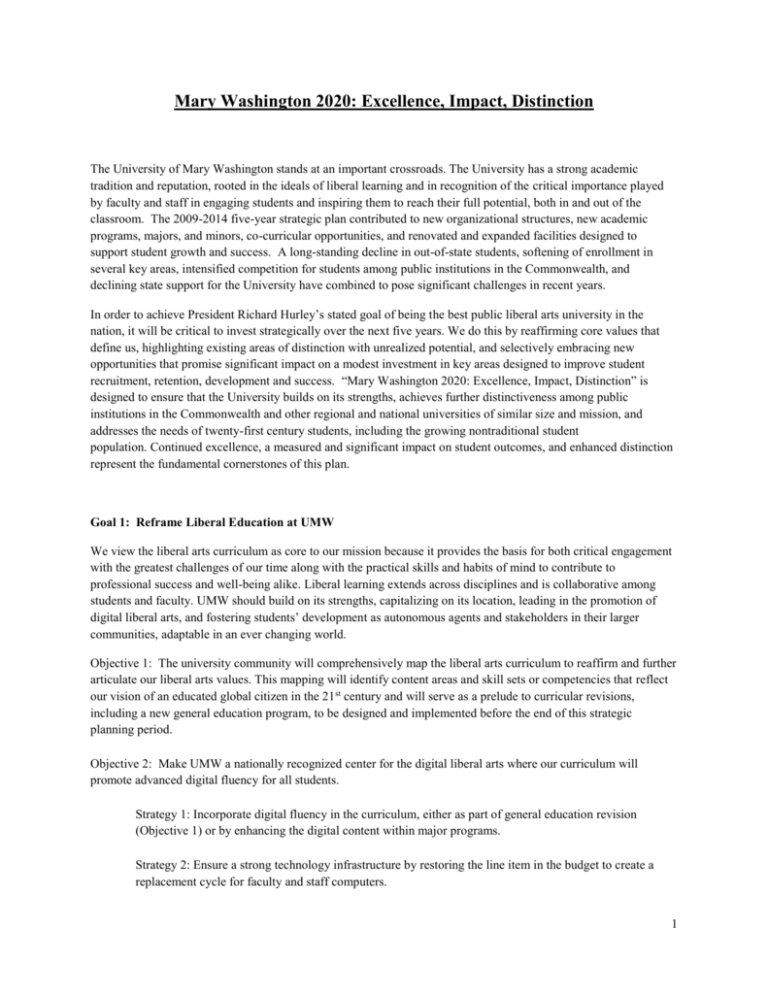
Mary Washington 2020: Excellence, Impact, Distinction The University of Mary Washington stands at an important crossroads. The University has a strong academic tradition and reputation, rooted in the ideals of liberal learning and in recognition of the critical importance played by faculty and staff in engaging students and inspiring them to reach their full potential, both in and out of the classroom. The 2009-2014 five-year strategic plan contributed to new organizational structures, new academic programs, majors, and minors, co-curricular opportunities, and renovated and expanded facilities designed to support student growth and success. A long-standing decline in out-of-state students, softening of enrollment in several key areas, intensified competition for students among public institutions in the Commonwealth, and declining state support for the University have combined to pose significant challenges in recent years. In order to achieve President Richard Hurley’s stated goal of being the best public liberal arts university in the nation, it will be critical to invest strategically over the next five years. We do this by reaffirming core values that define us, highlighting existing areas of distinction with unrealized potential, and selectively embracing new opportunities that promise significant impact on a modest investment in key areas designed to improve student recruitment, retention, development and success. “Mary Washington 2020: Excellence, Impact, Distinction” is designed to ensure that the University builds on its strengths, achieves further distinctiveness among public institutions in the Commonwealth and other regional and national universities of similar size and mission, and addresses the needs of twenty-first century students, including the growing nontraditional student population. Continued excellence, a measured and significant impact on student outcomes, and enhanced distinction represent the fundamental cornerstones of this plan. Goal 1: Reframe Liberal Education at UMW We view the liberal arts curriculum as core to our mission because it provides the basis for both critical engagement with the greatest challenges of our time along with the practical skills and habits of mind to contribute to professional success and well-being alike. Liberal learning extends across disciplines and is collaborative among students and faculty. UMW should build on its strengths, capitalizing on its location, leading in the promotion of digital liberal arts, and fostering students’ development as autonomous agents and stakeholders in their larger communities, adaptable in an ever changing world. Objective 1: The university community will comprehensively map the liberal arts curriculum to reaffirm and further articulate our liberal arts values. This mapping will identify content areas and skill sets or competencies that reflect our vision of an educated global citizen in the 21st century and will serve as a prelude to curricular revisions, including a new general education program, to be designed and implemented before the end of this strategic planning period. Objective 2: Make UMW a nationally recognized center for the digital liberal arts where our curriculum will promote advanced digital fluency for all students. Strategy 1: Incorporate digital fluency in the curriculum, either as part of general education revision (Objective 1) or by enhancing the digital content within major programs. Strategy 2: Ensure a strong technology infrastructure by restoring the line item in the budget to create a replacement cycle for faculty and staff computers. 1 Objective 3: Ensure students continue to have opportunities to work closely with outstanding faculty by attracting and retaining top candidates and rewarding their efforts with a workload conducive to excellent teaching and research endeavors. Strategy 1: Meet the benchmarks for faculty pay established by the updated 2011 compensation study while continuing to address salary compression. Strategy 2: In consultation with deans and department chairs, the provost will create a rational, equitable system that codifies the different faculty workloads across departments. This could involve a move to 32course option, a reinstitution of a banking system for independent studies and internships, or other strategies. Objective 4: Expand opportunities for student-faculty collaboration on undergraduate research and creative projects, building on tools and pedagogies currently in place. Strategy 1: Develop a summer institute model, similar to the summer science institute, serving at least three additional departments. Strategy 2: Commit additional resources to expand faculty/student research. Strategy 3: Expand Research and Creativity Day, either to include a fall session or to make the current day a non-instructional day, titled Research, Creativity, and Recognition Day and promoted as an opportunity for community outreach and recruitment. Objective 5: Prioritize the Jepson addition and renovation to ensure sufficient research and instructional space to serve growing student interest in STEM fields and collaborative faculty-student research. Goal 2: Establish and Promote Areas of Distinction UMW has several outstanding opportunities that with further development, support, and promotion will bring greater visibility and recognition to the university as a whole. Objective 1: Highlight disciplines that tap into the unique resources of our location at the confluence of the District of Columbia, Richmond, the U.S. Naval base at Dahlgren, and the Chesapeake Bay. Strategy 1: Engage departments to propose programs and courses for a “DC Semester” including but not limited to theatre and the arts, government, public policy, international affairs, economics, science, museum studies, social justice, and education. Strategy 2: Engage departments to propose programs and courses in Richmond related to state government, museum studies, history and historic sites, education, and the arts. Strategy 3: Engage departments to propose programs and courses in the natural sciences to utilize the resources of the Chesapeake Bay. Strategy 4: Engage departments to expand opportunities in areas such as security studies, physical and biological sciences, and data science at the naval base at Dahlgren. Objective 2: Enhance and promote our distinctive major in historic preservation as a program that capitalizes on UMW’s historic location and our strengths in digital technologies. 2 Objective 3: Review the needs in our large, popular majors. The provost will work with deans and department chairs of these majors to ensure advising capacity and course availability for traditional and transfer students. These majors serve large numbers of students and contribute in multiple ways to many programs, and their success is critical to the overall strength of the University. Objective 4: Extend Domain of One’s Own to spotlight UMW as a leader in digital pedagogies that prepare students for engaged citizenship and the 21st century workplace. Strategy 1: Beginning with the fall 2016 entering class, all students will be engaged in this initiative, integrated from admissions and orientation through to career development. Strategy 2: Ensure financial support and professional development opportunities for faculty and staff to create domains and incorporate them into the teaching and learning environment. Objective 5: Establish a certificate in honor, leadership and service that complements our Mary Washington traditions of leadership, community engagement, and personal integrity, exemplified in the legacy of Professor James Farmer and alumna Jean Donovan. Strategy 1: Increase the connection of our UMW values of honor, service, and leadership to the curriculum, through service learning courses and in academic programs in related areas such as ethics and non-profit management. Strategy 2: Expand co-curricular opportunities for certificate students to participate in campus-wide conversations about policy and other critical university issues. Goal 3: Position the fine and performing arts to strengthen and enhance the recognition and visibility of the University. The arts are central to the life of the University of Mary Washington and the greater Fredericksburg region. Hundreds of Mary Washington students are active every day in theatre, dance, visual arts, and music. As the primary gateway through which we welcome thousands of our neighbors to campus, the arts play a unique role in nurturing the valuable relationship the University enjoys with the community. The University is poised to accentuate the potential of the arts by investing in five key initiatives that will define UMW as an innovative destination for future students and audiences. This investment will establish the arts as a distinguishing hallmark of the University. Objective 1: Address the critical facilities needs of the arts, the physical footprint for which has not changed in over 40 years. Strategy 1: Design and construct a free-standing facility for theatre and dance to accommodate all performance, teaching, and ancillary needs. Sites both on- and off-campus, within walking distance from the Fredericksburg campus, will be explored. Strategy 2: Plan for a comprehensive renovation of DuPont, Melchers, and Pollard to address the specialized needs of music, art history, and studio art. Strategy 3: Explore expansion of the Dodd Auditorium stage to better serve the needs of the Philharmonic and other performing groups. 3 Objective 2: Develop a targeted recruiting plan that promotes the University’s teaching excellence in the arts to identify, recruit, admit, and yield talented students from Virginia and beyond. Objective 3: Expand resources devoted to student arts making on campus to ensure ample experiential learning opportunities that will engage students in classrooms, studios, galleries, theatres, and rehearsal rooms. Objective 4: Expand resources for guest artists to connect professionals with UMW students, thereby creating significant relationships with working artists that will enhance the visibility of the arts at UMW. Objective 5: Study the benefits and consequences of establishing a School of the Arts—initially as an entity within the College of Arts and Sciences--as a means of better serving students in the arts and elevating the visibility of the arts community at UMW. Goal 4: Promote Professional Development in the Liberal Arts Context Through the arc of students’ development, pre-admission through graduation and as alumni, UMW faculty and staff will create opportunities and provide the resources and training that will prepare students to flourish in the professional world. Objective 1: Establish a Center for Career and Professional Development. Strategy 1: The center will be located in the new University Center, on the entry-level from Ball Circle. This location is intended both to make access to the Center convenient for students and to lend visibility to the support provided by the Center. Strategy 2: The Center will be overseen by the Associate Provost for Academic Engagement and Student Success, who will recommend leadership and staffing needs. The Center will promote collaboration among all university partners engaged in students’ continuing professional development: Academic and Career Services and the internship program managed by that office, Alumni Relations, UMW’s Center for Economic Development, the three Colleges and the proposed Division of Continuing Education (see Goal 5), the Center for Honor, Leadership, and Service, and other critical partners such as Marketing and Events staff. In addition, the Center will work with faculty to ensure successful implementation of the objectives below. Resources from all of these sources will be leveraged to provide more pervasive and impactful professional development opportunities for students, with measureable outcomes. Objective 2: Develop strong connections between academic and career advising. Strategy 1: Ensure that faculty and staff have appropriate resources (including a comprehensive advising manual) and training to provide effective academic and career advising. Strategy 2: Ensure that all academic programs have effectively mapped and communicated applicable skills mastered by students who successfully complete their programs. Strategy 3: Develop opportunities to share best practices among faculty and professional advisors. Objective 3: Streamline and enhance collection of employment-related data from alumni on an established cycle. Data should be transparent and readily available for department and division use and for more effective communication about student professional success. 4 Objective 4: Develop and enhance digital networks and social media (such as departmental websites, LinkedIn, and Facebook) to support career exploration, mentoring opportunities, alumni engagement, and engagement with other regional professionals. Goal 5: Refocus Support for Adult, Transfer, and Graduate Students to Ensure Enrollment and Success Non-traditional students have long been integral to UMW’s enrollment profile and reflect our commitment to the region. Given the changing demographics of the region there is opportunity to enhance and expand our array of continuing education opportunities to better serve the community. Objective 1: Establish a Division of Continuing Education to oversee adult credit and non-credit programs. Strategy 1: The Division will oversee establishment of high quality programs as determined through market research, to serve the unmet needs of the large adult education population in the region, including veterans and other non-traditional students. Division staff will partner with the college deans and department chairs in identifying appropriate faculty staffing. Strategy 2: The Division will ensure that programs are delivered with the kind of flexibility and convenience suited to working adults (e.g., evening, weekend, on-line, hybrid, low-residency, 8-week semesters). Staff will support training to ensure pedagogical excellence, such as the Online Learning Initiative, while insuring availability of online courses to meet critical enrollment needs. Strategy 3: Division staff will coordinate and provide walk-in support for Stafford students as demand dictates. Objective 2: Establish a Transfer Center within the Office of Academic and Career Services to ensure the success of transfer students. Strategy 1: Transfer Center staff will connect relevant administrators and faculty at partner schools with their counterparts at UMW to develop articulation agreements with community colleges. Strategy 2: Transfer Center staff will provide advising support appropriate to the unique needs of transfer students, both before matriculation and in transition through their first semesters at UMW. Strategy 3: Transfer Center staff will work closely with Admissions, the Registrar, deans, and department chairs to ensure that the university can effectively support UMW transfer students. Objective 3: Build enrollment in our graduate programs to serve the needs of the area’s working adults and as a strategic enterprise to grow enrollment. Strategy 1: Establish aggressive, achievable annual enrollment goals for each graduate program and strategic recruitment plans to ensure success. Strategy 2: Enhance and bolster the existing 5-year Bachelor’s/Master’s programs in Education and Business. Strategy 3: Develop flexible scheduling and delivery systems to ensure that graduate program offerings are delivered in times, locations, and instructional methods that are most convenient to students. 5 Strategy 4: Develop new professionally-oriented graduate programs and courses that are appropriate to UMW’s mission and capabilities, based on market research. Goal 6: Enhance and Expand Opportunities for Student On-Campus Engagement The University of Mary Washington will build upon its strength as a primarily residential, highly engaged community to further invigorate and energize the quality of student life outside the classroom. Objective 1: The Office of Student Affairs will expand opportunities for student social activities. Strategy 1: Provide resources to increase the quantity and quality of student activities, developing a robust schedule of weekend student activities. Strategy 2: The office will increase the level of participation in student activities by widely publicizing events beginning early in the academic year. The office will utilize an enterprise scheduling mobile application for the events calendar (see Goal 7). Strategy 3: The Office of Student Affairs will support the development of student affinity organizations that provide opportunities for affiliation, service, social and other co-curricular activities. Such organizations, operating in conformity with UMW’s community values, will not discriminate in the selection of members and will expand and engage students from diverse backgrounds. Objective 2: Emphasize our ongoing success and investment in intercollegiate athletics to further enhance student life on campus. Strategy 1: The President will establish a task force to conduct a comprehensive feasibility study of establishing one or more additional intercollegiate men’s and women’s sports programs, including football. The study will conclude with recommendations by May 2016. Objective 3: Provide campus engagement to blend curricular and co-curricular learning opportunities. Strategy 1: Expand living and learning communities beyond the first year to serve as homes for affinity groups, students clubs or language communities. Student Affairs and Student Success programs will work together to propose and establish such communities. Strategy 2: Student Affairs and faculty will work together to expand curricular and blend co-curricular learning opportunities for students. Goal 7: Reaffirm our Commitment to Excellence in Support of University Operations The success with which the University recruits, retains, and graduates students is dependent on the support provided by staff, both on the “front lines” (in academic departments, Lee Hall, and elsewhere) and in “back offices” across our three campuses and in Eagle Village. Ensuring appropriate support for university staff is a fundamental value that helps the University fulfill its mission and enhances the well-being of its employees. 6 Objective 1: Ensure that UMW is able to hire and retain outstanding support staff who are enabled to contribute to overall student success. Strategy 1: Work with representatives in Richmond and other state agencies in the Fredericksburg region to align UMW salaries with the high cost of living in northern Virginia. Strategy 2: Conduct a comprehensive review of staff classifications and pay band assignments to ensure appropriate recognition of staff assignments. Strategy 3: Expand resources to support staff professional development, including reestablishing tuition support for staff seeking degrees relevant to their job responsibilities. Objective 2: Implement an enterprise scheduling system for course and events scheduling to ensure efficient and accessible use of campus space. 7
